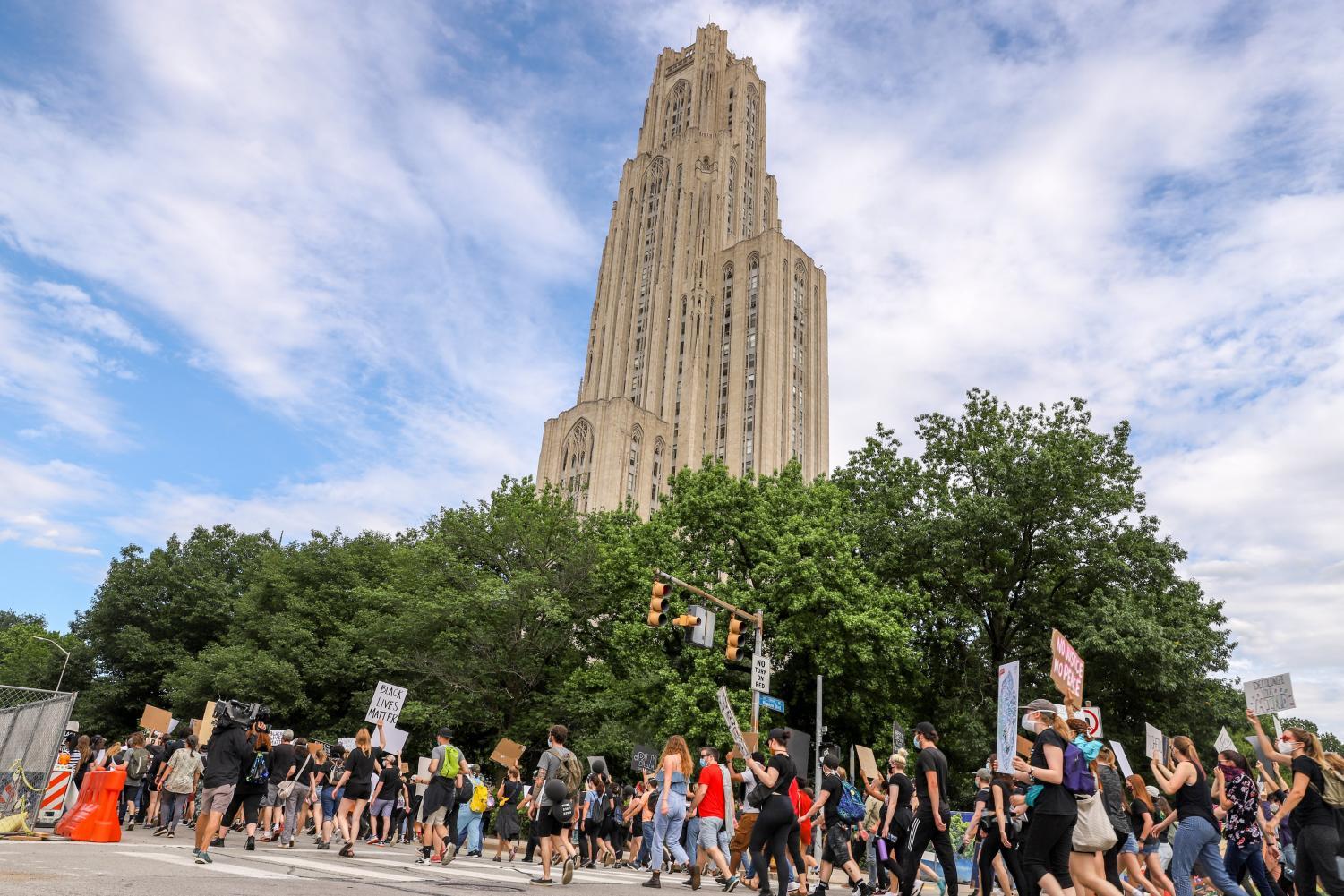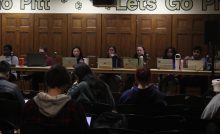‘Embarrassing’: Black student leaders criticize low Black student enrollment


According to Pitt data, Black students represented 5.26% of the undergraduate student body in 2019.
Morgan Ottley, the president of Pitt’s Black Action Society, remembers when she first visited Pitt four years ago for an admitted students day for minority students. But she said she encountered almost no minority students from Pitt during her visit.
“I don’t remember meeting any minority student organization, resources and opportunities for minority students or anyone from the Office of Diversity and Inclusion,” Ottley, a senior neuroscience major, said. “The most minority students I saw during that two-day trip were the students I came with.”
Ottley said this is indicative of a culture at Pitt that she believes needs to change to attract, and retain, more Black students. According to University data, Black students represented 5.26% of the undergraduate student body in 2019.
This percentage is the latest in a downward trend from the last 40 years. Black students made up about 14% of the student population in 1979, 10% in 1989, 9% in 2000 and 7% in 2010. Pitt received a “D” in the University of Southern California’s annual report card on the representation of Black students at public colleges and universities.
Increasing Black student enrollment was a key issue that prompted the BAS’s famous 1969 sit-in at the Cathedral of Learning. Ottley said it is “embarrassing” for Pitt that the statistics surrounding the percentage of Black students on campus is similar 50 years later.
“The University should be ashamed,” Ottley said. “You’re supposed to learn from history and then move on in the right direction. I feel like we just haven’t. This is a movement, not a moment.”
There is a variation in the data, though. Pitt spokesperson Kevin Zwick said the 5.26% reported by the University is actually an undercount because it follows a definition set by the federal government. Zwick said this definition does not count students who identify as both Black and another ethnicity as Black, but instead in the “two or more category.”
“While Pitt will continue to report population statistics based on these rules as required by law, future editions of the Fact Book will also note the demographic breakdown counting all students who identify as Black, which we believe is a more accurate representation,” Zwick said.
Zwick said using the more “accurate” definition, Black students in 2019 would make up 7.8% of the undergraduate population rather than 5.26%. He also noted that the number of first-year Black students enrolled at Pitt this semester is record-breaking, with 354 Black students making up 8% of the total first-year class.
Increasing Black student enrollment was one of the action items in a list of demands that BAS and 17 other Black student organizations sent to University administrators over the summer. The groups asked that the University increase the percentage of Black students on campus to 10% in the next five years, with an approximate 1% increase per year, separate from student athletes. This demand was based on the 5.26% reported by the University. They also wanted an admissions panel to be formed to increase enrollment and retainment of Black students.
Zwick said Pitt is committed to reaching the 10% goal in five years with a number of new initiatives.
“The University of Pittsburgh is committed to addressing the historic underrepresentation of Black students on our campuses,” Zwick said. “That strategy will include continuing to increase the involvement and engagement of Black Pitt students in the recruitment, enrollment and retention of Black high school students as well as in efforts aimed at encouraging admitted Black students to enroll.”
Destiny Mann, the president of the Black Senate and vice president of the BAS, meets with Kenyon Bonner, the vice provost and dean of students, every other week as part of the University’s response to the student demands. She also meets with other senior leadership including Provost Ann Cudd and Kathy Humphrey, the senior vice chancellor for engagement.
Based on these meetings, Mann said she believes Pitt wants to make a change, but she hopes it’s willing to take the necessary steps to do so.
“Administration is for admitting more Black students,” Mann, a junior Africana Studies and political science double major said. “I just hope that they’re for putting out the money that’s required to get to that point.”
Mann added that Black student leaders are tired from doing what they see as the University’s job.
“We’ve provided mental health resources, academic health, managed financial aid without getting paid and being full-time students,” Mann said. “We are exhausted.”
Leigh Patel, a professor in the School of Education and former associate dean of equity and justice, described higher education as “made out of the fabric of society.” She said based on policies throughout the last 60 years, it is possible to pinpoint the reason for many of the fluctuations in Pitt’s Black student population.
Patel explained that there was likely a significant increase in Black students at Pitt in 1979 because it was historically a period when desegregation in schools was in full swing. She said the consistent decrease since 2010 is likely due to decreased funding to public colleges and universities, following the economic collapse of 2008. State and local spending for public university students dropped to a 25-year-low in 2011, according to Reuters.
Patel said this loss in funding led to skyrocketing tuition prices and financial barriers to low-income students. These barriers disproportionately affect Black families, Patel said, because of generational blocks to wealth.
“Black people and other people of color have to work twice as hard to get half as far,” Patel said.
Patel said increasing Black student enrollment first involves removing financial barriers, and Ottley agreed. Ottley described the struggles she has experienced during her time at Pitt with securing scholarships. She said as a first-year student she received approximately $38,000 in scholarships, but Pitt unexpectedly decreased the scholarship to about $14,000 her sophomore year.
“Pitt truly slapped me in the face,” Ottley said.
Although, with connections at the University, Ottley said she was able to increase the scholarship to its original level, she experienced similar decreases every year along with other members of BAS. BAS included the creation of more than 50 scholarships, totalling hundreds of thousands of dollars, in their list of demands to the University,
“There has to be an incentive to go to this school,” Ottley said. “Right now, the biggest issue is money, which is why we added it to the list of our demands.”
Ottley added that Pitt should put in place more and better-funded community engagement programs to attract more Black students from Pittsburgh.
“They think that it’s beyond their reach,” Ottley said. “That comes down to how students are supported and how they’re groomed in this education system.”
Ottley said increasing Black student enrollment goes hand in hand with increasing Black faculty as well. In their demands, Black students asked that Black tenured faculty over the next 10 years reach 10% of all faculty, spread out across all corners of the University, not solely the Africana Studies department.
Ottley said it’s been difficult for her to navigate the neuroscience department, because no professor or researcher looks like her.
“Finding a Black professor at the University is literally like finding gold,” Ottley said. “As a neuro student, I want to see Black people in the department. I want to see people who look like me, so I know there’s a space for me in this field. It’s very discouraging and there were days I thought I couldn’t do it.”
Patel agreed that increasing Black faculty could increase the number of Black students.
“I think we need to have more Black faculty and Black leadership. That alters the relations of power,” Patel said. “One of the things higher education has gotten good at is optics and not changing power relations.”
Even though she is skeptical that Pitt will actively work to increase Black student enrollment, Ottley said she is cautiously optimistic after speaking to senior leadership and hopes to see systemic changes.
“Rather than trying to fix a broken system, they need to be thinking of more innovative systems,” Ottley said. “Discard the rough draft and propose something new.”
Recent Posts
SGB addresses concerns about ICE presence on campus, hears SJP lawsuit against administration, approves governing code bill
At its weekly meeting on Tuesday at Nordy’s Place, Student Government Board heard concerns about…
ACLU of Pennsylvania sues Pitt over SJP suspension
The ACLU of Pennsylvania filed a federal civil lawsuit against the University of Pittsburgh and…
Marquan Pope: The ultimate shark
One of the most remarkable things about sharks is that an injury doesn’t deter them.…
Who Asked? // Do we really get a summer vacation?
This installment of Who Asked? by staff writer Brynn Murawski mourns the seemingly impossible perfect…
Notes From an Average Girl // Notes from my junior year
In this edition of Notes From an Average Girl, senior staff writer Madeline Milchman reflects…
Meaning at the Movies // The Power of the Movie Theater
In this edition of “Meaning at the Movies,” staff writer Lauren Deaton discusses her love…

